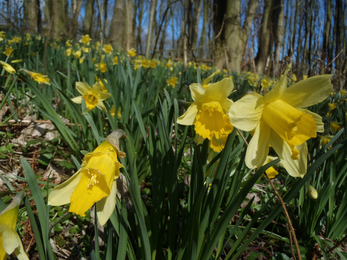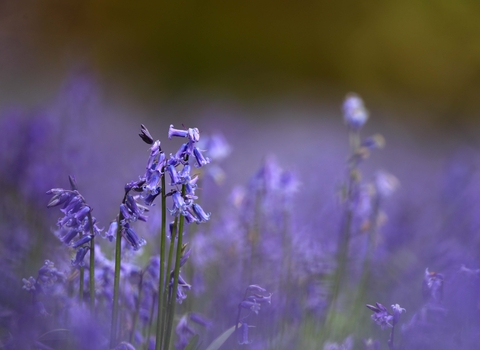
George's Hayes
Location
Know before you go
Dogs
When to visit
Opening times
Open at all timesBest time to visit
February to May, September to OctoberAbout the reserve
Highlights
- Visit in early spring to see the county’s largest colony of native wild daffodils.
- Fancy an early start? Then why not visit the reserve one morning in May to experience the dawn chorus as our woodland birds try to outdo each other in their own singing competition.
- Keen (and quiet!) early risers might also be lucky enough to see or hear red deer rutting in October
What’s in a name?
The reserve is made up of George’s Hayes (the largest block), Piggot’s Bottom and Square Covert. All of these woodlands are termed ‘ancient woodland’ which means that the ground has been continuously covered by woodland since 1600. But this doesn’t mean that the trees you see are over 400 years old! The woodlands you see today, formerly part of the old Beaudesert Estate, are largely as a result of extensive felling and replanting at some time in their history.
Variety is the spice of life!
Visit the reserve in spring to experience the wonderful display of woodland flowers. Look out for bluebells, yellow archangel, wood anemone and wild garlic. All of these plants are associated with ancient woodlands and do not easily spread naturally to newly planted woods. Our ancient woodland sites are therefore important places for these species.
But look above you and you won’t see such a range of species in the tree canopy. Historically this woodland would have supported a range of trees including ash, oak, elm, hazel and a range of other shrubby species. These are still present in small numbers but most of the trees you see will be sycamore. Long-term management of the reserve therefore aims to encourage a more diverse range of tree species through appropriate, selective tree felling.
But isn’t felling trees bad for wildlife?
Not necessarily! Many of our woodlands would have been managed to provide fuel and timber. But as the demand for these products has declined many have become unmanaged. Woodland management at George’s Hayes involves felling trees to create gaps for light to reach the ground layer through the tree canopy. Once these gaps are opened up they provide opportunities for tree seedlings to grow and become established. Trees don’t live for ever (although most of them certainly outlive us!) and it is important that there are new trees coming through to replace the older ones in future years.
Deer, deer! Cannock Chase is well known for its large number of red deer – one of only two species of deer native to Britain. If you’re quiet when you visit the reserve you may be lucky enough to see some of these magnificent creatures grazing in the open areas or browsing within the woodland. Deer are an important part of the UK’s wildlife and red deer are our largest mammal – it’s a memorable experience to come across your first red stag on a misty morning.
But deer also bring management issues in many woodlands and are increasing in number across the country. Deer grazing in open glades and clearings can be beneficial but excessive deer browsing of regenerating trees can cause long term problems for the future of some woodlands. Areas that have been previously clear felled within George’s Hayes have however regenerated with such large numbers of seedlings (mostly ash initially) that it is not currently considered that there is any conflict between the deer and the ongoing woodland management of the reserve.
Ode to a daffodil - William Wordsworth 1804
Not many wild flowers can claim to have inspired such well known poetry! If you want to see what all the fuss is about then visit the reserve in early spring to enjoy carpets of wild daffodils along the woodland floor.
Ash dieback
Sadly Ash dieback is affecting many of our nature reserves in Staffordshire. We have already had to carry out some felling in some of our woodlands and over the next few years we will have to continue to do so. This includes felling at George's Haye. Please head to our ash dieback page for more information.
This nature reserve is leased from Girl Guides Association





